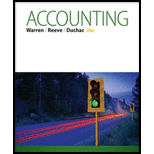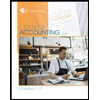
(1)
Adjusting entries indicates those entries, which are passed in the books of accounts at the end of one accounting period. These entries are passed in the books of accounts as per the revenue recognition principle and the expenses recognition principle to adjust the revenue, and the expenses of a business in the period of their occurrence.
Adjusted
Adjusted trial balance is a trial balance prepared at the end of a financial period, after all the adjusting entries are journalized and posted. It is prepared to prove the equality of the total debit and credit balances.
Rule of Debit and Credit:
Debit - Increase in all assets, expenses & dividends, and decrease in all liabilities and
Credit - Increase in all liabilities and stockholders’ equity, and decrease in all assets & expenses.
To record: The adjusting entries on April 30, 2016 of R Repairs and Services.
(1)
Explanation of Solution
a. The following entry shows the adjusting entry for accrued fees unearned on April 30.
| Date | Account Titles and Explanation | Debit ($) | Credit ($) |
| April, 30 | 9,850 | ||
| 2016 | Fees earned | 9,850 | |
| (To record the accounts receivable at the end of the year.) |
Table (1)
The impact on the
- Accounts Receivable is an asset, and it is increased by $9,850. So debit Accounts receivable by $9,850.
- Fees earned are component of stockholders’ equity and increased it by $9,850. So credit fees earned by $9,850.
The following entry shows the adjusting entry for supplies on April 30.
| Date | Account Titles and Explanation | Debit ($) | Credit ($) |
| April, 30 | Supplies Expense (1) | 11,540 | |
| 2016 | Supplies | 11,540 | |
| (To record the supplies expense at the end of the accounting period) |
Table (2)
The impact on the accounting equation for the above referred adjusting entry is as follows:
- Supplies expense is a component of stockholders’ equity, and it decreased the stockholders’ equity by $11,540. So debit supplies expense by $11,540.
- Supplies are an asset for the business, and it is decreased by $11,540. So credit supplies by $11,540.
Working Note:
Calculate the value of fees earned for the accounting period
c. The adjusting entry for recording
| Date | Account Titles and Explanation | Debit ($) | Credit ($) |
| April, 30 | Depreciation expense | 6,470 | |
| 2016 | | 6,470 | |
| (To record the depreciation on office equipment for the current year.) |
Table (3)
The impact on the accounting equation for the above referred adjusting entry is as follows:
- Depreciation expense is component of stockholders’ equity and decreased it, so debit depreciation expense by $6,470.
- Accumulated depreciation is a contra asset account, and it decreases the asset value by $6,470. So credit accumulated depreciation by $6,470.
d. The following entry shows the adjusting entry for unearned fees on April 30.
| Date | Account Titles and Explanation | Debit ($) | Credit ($) |
| April, 30 | Unearned Fees | 15,000 | |
| 2016 | Fees earned | 15,000 | |
| (To record the fees earned from services at the end of the accounting period.) |
Table (4)
The impact on the accounting equation for the above referred adjusting entry is as follows:
- Unearned fees are a liability, and it is decreased by $15,000. So debit unearned rent by $15,000.
- Fees earned are a component of Stockholders’ equity, and it is increased by $15,000. So credit rent revenue by $15,000.
e. The following entry shows the adjusting entry for wages expense on April 30.
| Date | Account Titles and Explanation | Debit ($) | Credit ($) |
| April, 30 | Wages expenses | 5,200 | |
| 2016 | Wages Payable | 5,200 | |
| (To record the wages accrued but not paid at the end of the accounting period.) |
Table (5)
The impact on the accounting equation for the above referred adjusting entry is as follows:
- Wages expense is a component of Stockholders ‘equity, and it decreased it by $5,200. So debit wage expense by $5,200.
- Wages Payable is a liability, and it is increased by $5,200. So credit wages payable by $5,200.
(2)
The revenues, expenses and net income of R Repairs and Services before adjusting entries
(2)
Explanation of Solution
The revenues, expenses and net income before adjusting entries of R Repairs and Services are stated below:
- Revenue = $294,750 (given)
- Expenses = $226,350 (2)
- Net income = $68,400 (3)
Working Notes:
1. Calculate the expenses before adjusting entries:
2. Calculate the net income before adjusting entries
Hence, the revenues, expenses and net income of R Repairs and Services are $294,750, $226,350 and $68,400 respectively.
(3)
The revenues, expenses and net income of R Repairs and Services after adjusting entries
(3)
Explanation of Solution
The revenues, expenses and net income after adjusting entries of R Repairs and Services are stated below:
- Revenue = $319,600 (5)
- Expenses = $249,350 (4)
- Net income = $70,040 (6)
Working Notes:
1. Calculate expenses after adjusting entries:
2. Calculate the revenue after adjusting entries
3. Calculate the net income after adjusting entries
Hence, the revenues, expenses and net income of R Repairs and Services are $319,600, $249,560 and $70,040 respectively.
(4)
The effect of the adjusting entries on the capital of K
(4)
Explanation of Solution
The capital of K will be reduced by $1,640 after the adjusting entry.
Due to the adjusting entry, there is a decrease in the net income of $1,640
Want to see more full solutions like this?
Chapter 3 Solutions
Accounting (Text Only)
- Dunlop Systems applies manufacturing overhead to products based on standard machine-hours. The budgeted fixed manufacturing overhead cost for the most recent month was $28,800, and the actual fixed manufacturing overhead cost for the month was $29,320. The company based its original budget on 7,200 machine-hours. The standard hours allowed for the actual output of the month totaled 6,800 machine-hours. a. What was the overall fixed manufacturing overhead budget variance for the month? b. What was the fixed overhead rate? c. What was the volume variance?arrow_forwardI need help with this general accounting problem using proper accounting guidelines.arrow_forwardI am looking for the correct answer to this general accounting question with appropriate explanations.arrow_forward
- I need help finding the accurate solution to this general accounting problem with valid methods.arrow_forwardI am looking for the correct answer to this general accounting problem using valid accounting standards.arrow_forwardCan you help me solve this financial accounting question using the correct financial procedures?arrow_forward
- I need assistance with this general accounting question using appropriate principles.arrow_forwardPlease help me solve this financial accounting question using the right financial principles.arrow_forwardPlease provide the solution to this general accounting question with accurate financial calculations.arrow_forward
- A product sells for $25 per unit with variable costs of $15 per unit. Fixed costs are $100,000. Calculate the break-even point in units and sales dollars.arrow_forwardCalculate the labor rate variance and labor efficiency variance.arrow_forwardCan you explain this general accounting question using accurate calculation methods?arrow_forward
 College Accounting, Chapters 1-27 (New in Account...AccountingISBN:9781305666160Author:James A. Heintz, Robert W. ParryPublisher:Cengage Learning
College Accounting, Chapters 1-27 (New in Account...AccountingISBN:9781305666160Author:James A. Heintz, Robert W. ParryPublisher:Cengage Learning Intermediate Accounting: Reporting And AnalysisAccountingISBN:9781337788281Author:James M. Wahlen, Jefferson P. Jones, Donald PagachPublisher:Cengage Learning
Intermediate Accounting: Reporting And AnalysisAccountingISBN:9781337788281Author:James M. Wahlen, Jefferson P. Jones, Donald PagachPublisher:Cengage Learning College Accounting, Chapters 1-27AccountingISBN:9781337794756Author:HEINTZ, James A.Publisher:Cengage Learning,
College Accounting, Chapters 1-27AccountingISBN:9781337794756Author:HEINTZ, James A.Publisher:Cengage Learning,- Principles of Accounting Volume 1AccountingISBN:9781947172685Author:OpenStaxPublisher:OpenStax College
 Managerial AccountingAccountingISBN:9781337912020Author:Carl Warren, Ph.d. Cma William B. TaylerPublisher:South-Western College Pub
Managerial AccountingAccountingISBN:9781337912020Author:Carl Warren, Ph.d. Cma William B. TaylerPublisher:South-Western College Pub College Accounting (Book Only): A Career ApproachAccountingISBN:9781337280570Author:Scott, Cathy J.Publisher:South-Western College Pub
College Accounting (Book Only): A Career ApproachAccountingISBN:9781337280570Author:Scott, Cathy J.Publisher:South-Western College Pub





